Calling all Bargain Hunters: It’s Time To Scoop Up Great Deals On Shrubs And Start Your Fall Planting!
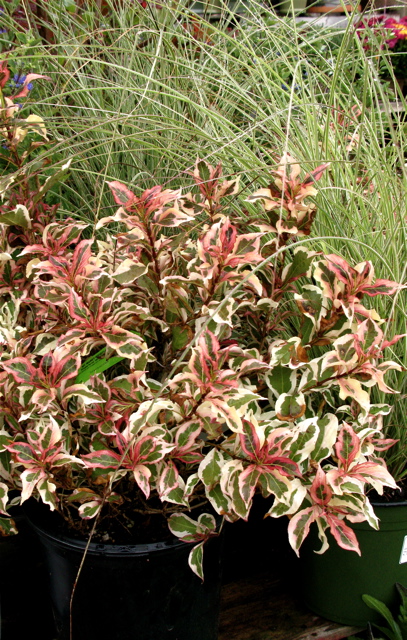 Weigela florida ‘My Monet’ & Miscanthus sinensis ‘Morning Light’
Weigela florida ‘My Monet’ & Miscanthus sinensis ‘Morning Light’
Pst… Want to know a secret? I really must confess. I have been having a bit of fun lately with other people’s money. No, no. It’s nothing like those scoundrels on Wall Street that you have been reading about. Permission has been granted. You see, for several weeks now, I have been shopping for my clients’ new gardens. Day in and day out, I have been oohing and ahhing, ogling and caressing, row upon row of ornamental shrubberies. OK, OK, I know. Don’t roll your eyes. It’s not everyone’s idea of a guilty pleasure. But as you may have noticed, I am a little horticulturally obsessed. To me, wandering around nurseries for weeks on end is pretty close to bliss. And while I am shopping for all of these soon-to-be installed gardens, you know of course that I am also scooping some things up for myself.
So, I really must let you in on my pleasure. And do you want to know the best part? It’s the sales. Seriously. Get out there my friends! There are some shocking deals and discounts to be found at garden centers in late summer. And now is the perfect time to take advantage of slashed prices on trees and shrubs – during fall planting season.
September is usually a super busy time for gardeners. The weather has started to cool down, and there are things to divide, move and cut back. This is also the ideal time to fill in newly designed and renovated gardens with perennials like peonies and all of those gorgeous spring blooming bulbs. And best of all, if you are in the market for some garden structure, it’s prime time for planting ornamental shrubs. Other than very early spring, autumn is really the safest time to plant, (or move), shrubs in cold winter climates like New England. Fall planting should be carried out when temperatures have cooled, but at least a month before the ground freezes. In New England, I usually begin my fall planting in early September. I use September 30th as a cut-off date for planting most evergreens or conifers, and October 31st as a last planting date for deciduous shrubs, (some years, the temperatures are more flexible than others). In the more southerly parts of the United States, the planting and moving of shrubs can begin later in fall and continue throughout winter, (as long as the soil remains frost-free and workable). Why plant shrubs in fall? As temperatures cool down and the growing season draws to a close, woody plants begin to go into seasonal dormancy. Shrubs planted at this time of the year, (early autumn in the Northeast and longer, into early winter in other regions of the US), have weeks or months left to settle in before the ground freezes. With energy no longer directed toward above-ground growth, early fall planting gives shrubs plenty of time to develop strong root systems. And as an added bonus, many garden centers and nurseries begin to mark-down shrubs in September, in order to reduce stock before winter. The selection may be a bit diminished, but if you keep an open mind, there are fabulous deals to be found! So, if you have been coveting some new cultivar at the local greenhouse, or if you would like to add a bit of season-spanning interest to your garden design, this is the perfect time to consider a planting plan and to shop for bargains.
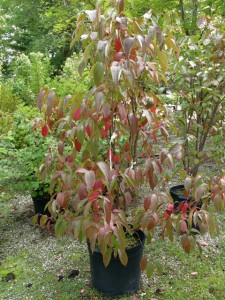 Viburnum lentago (Nannyberry viburnum), at a nursery, showing hints of fall color
Viburnum lentago (Nannyberry viburnum), at a nursery, showing hints of fall color
Now that I have stirred up the pot, I should give some fair warnings. Before you run out the door with checkbook and credit card in hand, it is very important that you have a close look at your garden. Remember that shrubs and trees are more permanent additions to the landscape than annuals and perennials. Once a shrub is settled in, it is difficult to move. So, spend some time thinking about your available space, light and growing conditions. If you think you see a good spot for a new addition, take careful measurements of the space and stick a reminder in your wallet. Now is a good time to note other conditions as well. Is your garden protected from or exposed to wind? Is the site sunny, shaded, or somewhere in between? Do you know your soil pH, (is it acid or alkaline or neutral)? Make time to do a soil test if you are unsure. Are you familiar with your USDA hardiness zone, (see NGA’s map here)? Â And last but not least, consider your garden design. What is your landscape missing? Do you want to add vertical interest to a relatively flat topography? Do you need to blend your garden into the edge of a woodland, or to create a background in order for your perennials to stand out? Is your garden lacking season-spanning interest, (in the form of flowers, fruit, foliage, bark, varied shapes)? Whatever your garden-design needs, shrubs have a lot to offer. It is easy to get overwhelmed in the middle of all those gorgeous plants. Thinking clearly about what you want and need before you head out to bargain-hunt is a really good idea.
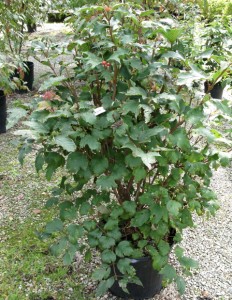 A nice Viburnum sargentii ‘Onadaga’ specimen at a local nursery
A nice Viburnum sargentii ‘Onadaga’ specimen at a local nursery
When shopping for woody plants, I would like to offer you some advice from years of end-of-the-season buying. I know all to well how tempting those slashed prices can be. But. Does the shrub should look healthy? Really check it over. Look for evidence of new growth, (shoots of soft wood from the summer), and healthy foliage. Of course we have to be a bit less critical in the latter part of the year. Some brown or dried leaves are to be expected on deciduous shrubs in autumn. However, a pot filled with weeds, suckers and exposed roots indicates that the plant was not well cared for at the garden center throughout the summer. Think twice about scraggly looking shrubs. Certainly, if you find a rare-gem at an absolute fire-sale, or favorite cultivar you have been seeking for years, you may want to gamble. (Full disclosure: I have found some great plants in compost bins). Just keep in mind that acquiring a diseased plant can bring trouble into your healthy garden, so proceed with caution. Any plant infested with insects or fungus isn’t worth the risk. Once you get your shrubby new treasures back home, it is important to immediately begin caring for them. Never leave your shrubs in a hot car or in the middle of your driveway. Place your new plants in a cool spot, water them thoroughly and try to plant them as soon as possible. When you are ready to begin planting, thoroughly water your plants one more time and set them aside while you prepare the site.
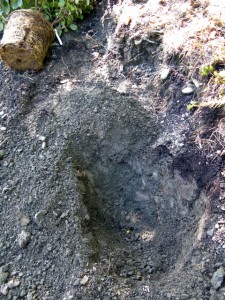 Dig a wide planting hole (at least 2 to 3 times the size of the root ball), as shown here
Dig a wide planting hole (at least 2 to 3 times the size of the root ball), as shown here
Dig a good hole for your shrub, (see photo above). You are preparing the ground where your plant will spend the rest of its life. Be sure to dig deep and wide. Remove rocks, roots and sticks. Never try to cram a shrub into an inadequate space. You want loose soil beneath the plant, and on all sides. I never add commercial fertilizer to planting holes, nor do I feed shrubs during fall planting. I like to add slow release fertilizer to my new shrubs in early spring. However, I do add a bit of high quality compost to the unearthed soil before returning a few inches to the bottom of the planting hole and the remaining backfill for the plant (I also top-dress the soil with a layer of compost once planting is complete).
Now you are ready to remove the shrub from its pot. Carefully examine the plant’s roots and ‘tease’ them a bit if they are exposed and matted at the edges of the soil (see photos below). If the roots are very dense and tangled, (pot-bound), you may need to cut (root prune), the roots with a knife. Make small vertical slits in the root-mass, (about 1/4-1/2″). This is very important. In order for the roots to move out and down into the surrounding garden soil, they must be unbound or they will strangle. Next, set your shrub into the planting hole. Be sure that the top of the root ball is even with, or ever so slightly below the top of the hole. If you are uncertain of planting depth, ask your retailer for guidance before you leave the nursery. Adjust the soil in the base as necessary.
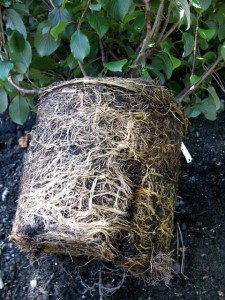 A season’s worth of tightly bound roots. These need to be loosened by ‘teasing’
A season’s worth of tightly bound roots. These need to be loosened by ‘teasing’
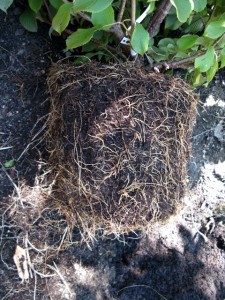 Roots loosened with vertical slices, then ‘teased” free with fingertips
Roots loosened with vertical slices, then ‘teased” free with fingertips
Once a plant is properly positioned and ready to be settled in, I like to add water to the plant and the planting hole as I back fill with soil. This helps to avoid hazardous air-pockets without compacting the loose dirt. When I reach the top of the hole, I create a low soil-berm around the plant, and I fill it with a water. If I have the time, I will allow the soil to settle for a couple of days, and then check for air pockets and add dirt if needed before I spread a thick, (2-3 inch), top-layer of mulch over the root-zone. Unless you receive regular (twice weekly or more), soaking rain, it is very important to water your new plants regularly (provide large shrubs with at least an 5 gallons or more of water, twice per week), until the ground freezes. I can not stress this enough. More shrubs die from dehydration than any other cause. Â Protect your investment by installing a soaker hose on a timer if necessary.
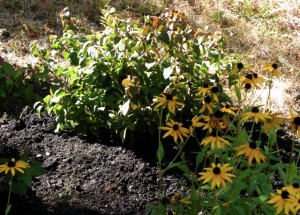 Newly planted Viburnum plicatum ‘Newport’ in a hillside grouping
Newly planted Viburnum plicatum ‘Newport’ in a hillside grouping
Check your plants regularly to be sure they are adjusting well to their new homes. Watch for insects and fungal infections and address any symptoms immediately before they grow into larger problems. If you live in a cold climate with long, harsh winters, it is wise to double check mulch at the root zone of your new shrubs and replenish if necessary. Some shrubs may also need protection from gnawing rodents, (such as wire-mesh base-collars for example). Your new shrubs will benefit from a slow-release fertilizer in spring (follow manufacturer’s instructions), so make a note in your calendar if you think you might forget. I hope you will take advantage of the bargains out there if you can. There is nothing like a great deal, and the memory of springtime’s magic, to inspire a fall planting-spree. Good luck, and have fun out there !
 Viburnum trilobum (American Cranberry Bush Viburnum), ‘Baily Compact’
Viburnum trilobum (American Cranberry Bush Viburnum), ‘Baily Compact’
Photography and Text â“’ Michaela Medina/The Gardener’s Eden. All images, articles and content on this site (with noted exceptions), are the original, copyrighted property of The Gardener’s Eden and may not be reposted, reproduced or used in any way without prior written consent. Contact information is in the left side bar. Please do not take my photographs without asking first. Thank you!Â
Do you enjoy The Gardener’s Eden? You can help support this site by shopping through affiliate links. A small percentage of each sale will be paid to this site, helping to cover web hosting and maintenance costs. Thank you so much for your support!

2 Replies to “Calling all Bargain Hunters: It’s Time To Scoop Up Great Deals On Shrubs And Start Your Fall Planting!”
Comments are closed.